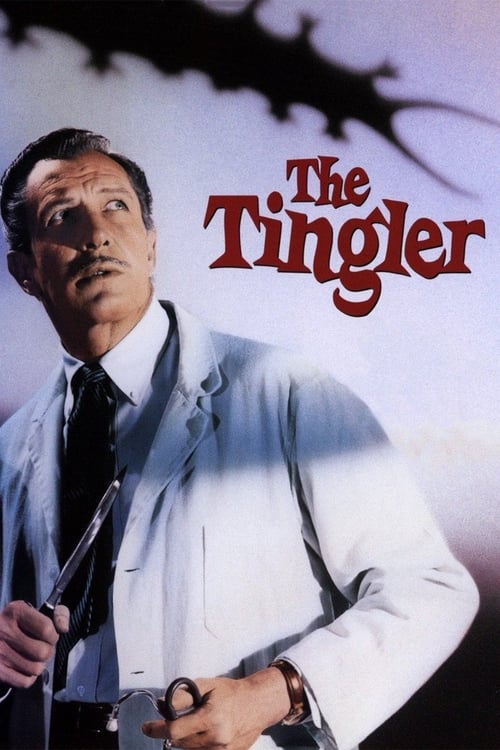Director William Castle started his career in show business at age 15, when he dropped out of school to join the Dracula play’s road production. Bela Lugosi himself recommended Castle for the job of assistant stage manager. He worked on several more jobs on Broadway and became a theater producer and promoter himself. He spent the forties and much of the fifties working for Columbia pictures before striking out on his own, promoting his films with elaborate, sometimes expensive, gimmicks.
For Macabre, he handed out $1,000 life insurance policies from Lloyds of London that covered all attendees for the risk of dying of fright. The second, House on Haunted Hill, featured a skeleton prop wired to fly at the audience at just the right moment. For The Tingler, he had some theater seats fitted with little motors that would vibrate during some scenes. But that wasn’t all. Both an introductory lecture and the movie’s dialogue encouraged the audience to scream when they were frightened.

Show emotion? But… I’ll die!
There was also one remarkable special effect, but we’ll get to that.
Dr. Chapin (Vincent Price) is a pathologist deeply interested in the human physiological response to fear. Chapin has noticed that many people experience a tingling sensation in their spines when they are frightened. He has also noticed, through his autopsies, that people who died during moments of great fright have small fractures along their backbones. His theory --- and it’s a doozy --- is that fear causes the sudden growth of a parasitic creature he names the “Tingler.”
Scriptwriter Robb White --- Castle’s frequent collaborator during this independent period and a successful author of young adult adventure novels --- takes great pains to encourage the audience to participate. The movie opens with William Castle himself addressing the camera, encouraging the audience to scream and warning that trying to keep your composure risks injury and death. “Don’t be embarrassed about opening your mouth and letting rip with all you got,” he says. “A scream at the right time may save your life.”

Like now, for instance.
Chapin himself explains this more than once in expository bits half delivered to his scene partner but also half-turned to face the camera:
We know that fear energizes it, gives it strength. And that it’s extremely powerful. Fear causes the Tingler to spread along the spinal column, and with those arm-like things between the vertebrae, forces it to become arched and rigid… screaming seems to stop it from bending the spinal column. Screaming may dissolve it, or if it’s a living organism, kill it.
With his theory thus explained and the audience yet again instructed, Chapin decides to photograph a Tingler. To do so, he has to x-ray someone at the exact moment when they are frightened to death. Chapin and his wife hate each other’s guts, which presents one opportunity. And if that doesn’t work, his friend’s wife is both deaf and mute. She cannot scream; therefore, she cannot kill the Tingler should it take ahold of her…
The most famous part of this movie is when the film appears to break. A silhouette of a creeping Tingler is projected against a white screen. “Scream for your lives!” exhorts Vincent Price. “The Tingler is loose in this theater! And if you don’t scream, it may kill you!” This is when the seats would start vibrating.

Please stop, I have a very serious vestibular disorder.
Sitting on my perfectly normal couch, watching the movie with headphones, I contemplated how some movies really do need to be seen in a theater.
Despite all the hokeyness of these scenes and others, The Tingler really is a remarkably well-paced, engaging, and even well-acted mad-scientist B-movie. Vincent Price’s expositions rarely get boring, and he never seems stiff or wooden. Price can deliver the most absolute nonsense with extraordinary sincerity. And it is easy to believe Chapin adores his sister-in-law like a daughter as much as he detests his greedy, duplicitous, emotionally abusive wife. I care far more about these characters than most other B-movie characters; there’s real sensitivity in some performances. But no one is in danger of winning any Oscars.
Oh, and about that special effect. Most of the film looks absolutely stunning in the Shout! Factory restoration I watched. The image is sharp, the sound excellent, and the black-and-white film seems almost brand new. There are a few cuts, however, where the contrast turns very weird. Washed out, grainy, even significantly degraded. These scenes have bright red spot color --- blood running from a faucet, an arm reaching out of a blood-filled bathtub.

The bath bomb had a little too much fizz in it.
It turns out it is not spot-color. The whole scene was shot in color. It’s just everything that is not red is painted black-and-white. Including the actress. It’s a clever idea and a startling effect, just … maybe not quite as successful as Castle had hoped.
William Castle would go on to make many, many more movies. The House on Haunted Hill would get remade in 1999 by William Malone. 13 Ghosts would be remade in 2001 by Steve Beck.
No one has remade The Tingler. Perhaps no one wants to risk bringing the creature back to life.

You must be this tall 💁🏻♂️ to ride the Vincent.

